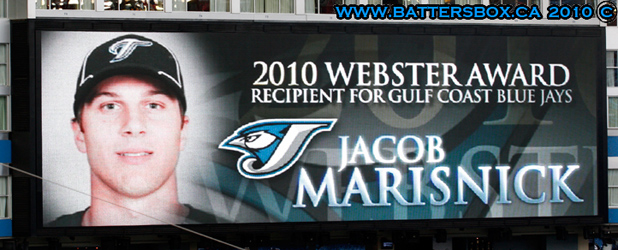20. Brad Emaus, 2B
Born March 28, 1986. Selected in the 11th round of the 2007 draft.
| Year | Age | Level | AB | 2B | 3B | HR | BB | K | SB | CS | AVG | OBP | SLG |
| 2007 |
21 |
A- |
136 |
6 |
0 |
2 |
12 |
26 |
2 |
0 |
.228 |
.298 |
.316 |
| 2008 |
22 |
A+ |
473 |
34 |
3 |
12 |
60 | 56 | 12 |
4 |
.302 |
.380 |
.463 |
| 2009 |
23 |
AA |
505 |
28 |
2 |
10 |
59 |
69 |
10 |
3 |
.253 |
.336 |
.376 |
| 2010 | 24 | AA | 136 | 7 | 0 | 5 | 31 | 19 | 5 | 0 | .272 | .402 | .434 |
| 2010 | 24 | AAA | 309 | 25 | 3 | 10 | 50 | 50 | 8 | 2 | .298 | .395 | .495 |
There isn't a whole lot not to like about Brad Emaus. Aside from a horrible month in 2009, he has shown steady progression at each level of the minors culminating in a fairly dominant three month stay in Las Vegas. Emaus has an incredible knack for plate discipline highlighted by his combined 81:69 BB:K rate in 2010. As an added bonus, when he finds his pitch he often smacks it for extra bases, combining for 55 of them this past season. While he doesn't have blazing speed, he's a smart baserunner and can steal when needed.
The only two real knocks on Emaus are his lack of above-average power and his inability to really stick at a position. Addressing the former, his sturdy frame (6', 200 lbs) will likely allow him to hit double digit homers at any level. As for the latter, this appears to be a genuine concern. His defense has been described as passable which isn't really what you want from your second baseman. Emaus has been tried at SS and 3B as well and hasn't found his groove at either of those. While he will almost certainly carve out a major league career, he may be reduced to a super-sub utility role. Otherwise if his defense progresses, he could eventually find himself as a starting second baseman.
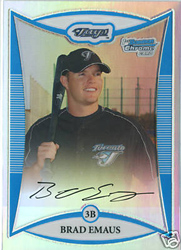
19. Darin Mastroianni, CF
Born August 26, 1985. Selected in the 16th round of the 2007 draft.
| Year | Age | Level | AB | 2B | 3B | HR | BB | K | SB | CS | AVG | OBP | SLG |
| 2008 |
23 |
A |
325 | 10 | 4 |
3 |
31 | 77 | 30 | 1 | .228 | .302 |
.311 |
| 2009 |
24 |
A+ |
231 | 11 | 2 | 0 | 37 | 38 | 32 | 7 | .325 | .426 | .390 |
| 2009 |
24 |
AA |
247 | 10 | 2 | 1 | 39 |
45 | 38 | 8 | .271 | .372 |
.340 |
| 2010 | 25 | AA | 525 | 25 | 7 | 4 | 77 | 96 | 45 | 10 | .301 | .390 | .398 |
The Jays drafted Mastroianni in 2007 out of Division II Southern Indiana. A middle infielder at the time, Mastroianni would play primarily at second base in his debut season in Low-A ball, before being shifted to centre field and A ball to start the 2008 campaign. Though he struggled in Lansing, the speed that induced the team to shift him to the outfield was evident, as he was caught stealing once against thirty successes. He followed up his 2008 with a monstorous (relatively speaking) 2009, where between Florida State and New Hampshire he stole 70 bases and put up a cumulative .297/.398./364 line. 2010 saw Mastroianni maintain his plate discipline while upping his slugging percentage, setting career bests in doubles, triples and homers while still going 45/55 on the basepaths.
Probably the best basestealer in the organization (until Anthony Gose figures out how to not get caught 50 times a year), Mastroianni has blazing speed in centre and looks to work the count when at the plate. He is primarily a singles hitter and will almost certainly never have much pop (unless Cito comes back as batting coach...) Still, he is a high average, high on base guy, something the Jays have been lacking in recent years. Mastroianni is relatively old, turning 25 about a month ago, and after 2 good years in New Hampshire it is time for the club to promote him to Las Vegas, assuming they are willing to put him on the 40-Man roster. With a good camp it is possible he could claim the 4th outfielders job with the Jays in 2011, as he is a strong defender who figures to have a chance to hit at least as well as any of the other guys the Jays have trotted out in this role the last few years such as Dewayne Wise and Jeremy Reed. At the very least he is due a cup of coffee at the end of the 2011 season.
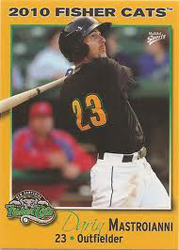
18. Brad Mills, LHP
Born March 5, 1985. Selected in the 4th round of the 2007 draft.
| Year | Age | Level | G | GS | IP | H/9 | HR/9 | BB/9 | K/9 | FIP |
| 2008 |
23 |
A |
15 |
15 |
81.1 |
7.86 |
0.33 |
3.10 |
10.18 |
2.63 |
| 2008 |
23 |
A+ |
6 |
6 |
33.1 |
6.75 |
0.54 |
3.24 |
9.45 |
2.96 |
| 2008 |
23 |
AA |
6 |
6 |
32.2 |
6.61 |
0.55 |
3.31 |
8.82 |
3.23 |
| 2009 |
24 |
AAA |
14 |
14 |
84.1 |
8.86 |
0.64 |
3.74 |
7.68 |
4.36 |
| 2009 |
24 |
MLB |
2 |
2 |
7.2 |
16.43 |
4.70 |
7.04 |
10.57 |
9.88 |
| 2010 |
25 |
AAA | 20 |
20 |
112.1 |
9.45 |
1.20 |
3.45 |
8.01 | 4.36 |
| 2010 |
25 |
MLB |
7 | 3 |
22.1 |
8.06 | 0.81 | 5.24 | 7.25 | 4.52 |
The Blue Jays thought Mills was so nice, they drafted him twice. Toronto first selected the Mesa, Arizona native in the 22nd round of the 2006 amateur draft. However, he wanted to go back to Arizona for his senior season and complete his engineering degree. He boosted his draft stock by being selected in the 4th round of the 2007 draft.
The 5-foot-11, 185-pound lefty rose quickly up the minor league ladder. After a brief stint in Auburn in which he went 2-0, he compiled a 13-5 record and a 1.95 ERA with Lansing, Dunedin and New Hampshire in 2008. He began last season with Triple-A Las Vegas but was called up to Toronto last June when Casey Janssen went on the disabled list with an inflamed shoulder. He earned a no-decision in his major league debut in Philadelphia but was pounded at the Dome by the Phillies in his next start. In his two appearances against the then-defending World Series Champions, he allowed four home runs, including a 500-level upper decker by former Jay Jayson Werth.
He began the 2010 campaign back in Las Vegas but was called up for a spot start against the visiting Baltimore Orioles in late July. That night, he earned his first major league victory by pitching seven shutout innings and striking out four batters. He reached the century mark in strikeouts in Las Vegas and has averaged almost a strikeout an inning in his minor league and pro career. However, walks remain a concern as he has walked over three batters per nine innings in the minors and over five in his brief stints in the majors.
According to Fangraphs.com, Mills’ fastball is about 85-86 MPH with a 74 MPH changeup and a 71 MPH curveball. Compared to last season, Mills is throwing his fastball nearly 65 percent of the time and his changeup 25 percent of the time. He is throwing 15 percent more fastballs from last season and 12 percent fewer curveballs. His first three appearances were as a starter with the Jays but his last four have been out of the bullpen. That appears to be his long-term role with the club in 2011.
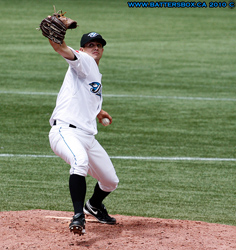
17. Moises Sierra, OF
Born September 24, 1988. Signed as a non-drafted free agent.
| Year | Age | Level | AB | 2B | 3B | HR | BB | K | SB | CS | AVG | OBP | SLG |
| 2008 |
20 |
A |
489 |
16 |
5 | 9 |
26 |
114 |
12 |
11 |
.246 |
.297 |
.364 |
| 2009 |
21 |
A+ |
459 | 24 | 2 | 5 | 34 | 66 | 10 |
2 | .286 |
.360 |
.393 |
| 2009 |
21 |
AA |
36 |
1 | 0 | 1 |
1 |
8 |
0 |
31 | .353 |
.361 |
..471 |
| 2010 | 22 | R | 38 | 2 | 0 | 1 | 4 | 8 | 0 | 0 | .265 | .342 | .412 |
| 2010 | 22 | A+ | 40 | 1 | 0 | 1 | 1 | 11 | 0 | 1 | .162 | .175 | .27 |
Sierra was the BB #2 Jays prospect at the end of 2009, and with good reason. Still only 20, he put up a strong full season line in the pitcher friendly Florida State League - significantly better than Anthony Gose's cumulative line between the Phillies and the Jays in A+ ball this year at the same age, to make one comparison. Add in the fact that Sierra has an absolute cannon for an arm in right field, a bit of speed and power potential down the road and you can see why we were so high on him. Alas, the best laid plans of mice and men.
Sierra missed the beginning of the 2010 season with a micro-fracture in his shin, and most of the later half of the year with a broken hamate bone. In total he managed to appear in only 20 games this season, and essentially lost a year of development time, though he will likely play winter ball. He doesn't have a long track record of success, with 2009 being a clear standout year, and much of his potential has been based on his success despite being young for his league, which will no longer be the case in Duendin and only marginally so in New Hampshire. With that being said, his walk rate has improved from year to year, and while he doesn't hit a ton of home runs, his doubles have also risen continuously. 2011 will be an important year for Sierra, and he will need to hit the ground running to regain his status as one of the organization's top prospects.
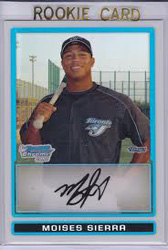
16. Joel Carreno, RHP
Born March 7, 1987. Signed as a non-drafted free agent.
| Year | Age | Level | G | GS | IP | H/9 | HR/9 | BB/9 | K/9 | ERA |
| 2008 |
21 |
A- |
15 |
13 |
76.1 |
8.75 |
0.71 |
2.24 |
10.02 |
3.42 |
| 2009 |
22 |
A- |
2 |
2 |
11.0 |
4.91 |
0.00 |
2.45 |
9.82 |
0.82 |
| 2009 |
22 |
A |
14 |
14 |
79.2 |
8.64 |
0.56 |
3.28 |
7.00 |
3.62 |
| 2010 |
23 |
A+ |
27 |
25 |
137.2 |
9.64 |
0.52 |
1.96 |
11.31 |
3.73 |
It's probably not too outrageous a thing to say that Joel Carreno had the best year of any pitcher in the Jay's minor league system, and perhaps the best year out of any player. He struck out an eye popping 173 batters in 137.2 innings, while allowing only 30 walks - a K/BB ratio of 5.77/1. To top that off he only allowed 8 home runs, making him a FIP machine - it was 2.36, one of the lowest marks in the minors for a pitcher with that many innings. But wait, there's more. After the FSL All Star Game Carreno threw 71 innings, striking out 90 and walking only 11. In 30.2 innings in August and September it was 35/3. While Carreno is not particularly young, relatively speaking, that's not his fault. Despite being considered organizational filler up to this point, he has essentially been anywhere from very good to dominant at every level he's pitched at; the Jays have just moved him along very, very slowly. It's unlikely things will change next year, and he seems primed to start the season in New Hampshire, where he will bring his low-90s fastball and strong breaking stuff. Because of their cautious approach and pitching depth, 2012 may be a realistic timeframe for Carreno to make the show.
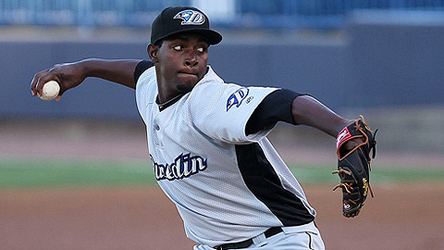
15. Chad Jenkins, RHP
Born December 22, 1987. Selected in the 1st round of the 2009 draft.
| Year | Age | Level | G | GS | IP | H/9 | HR/9 | BB/9 | K/9 | ERA |
| 2009 |
22 |
A |
13 |
13 |
79.1 |
9.87 |
0.57 |
1.47 |
7.26 |
3.63 |
| 2009 |
22 |
A+ |
13 |
13 |
62.1 |
10.54 |
0.87 |
2.60 |
6.06 |
4.33 |
Some around here have considered Jenkins, the Jays' #1 pick in 2009, a disappointment due to his underwhelming numbers. While it's true Chad didn't set the minors on fire in his first season, his performance was very respectable. The most encouraging part of Jenkins' season is that he has two very clear strengths: control and ground ball tendencies. Chad's walk rate was a miniscule 1.47 in Lansing and a still-good 2.60 after a mid-season promotion, and his ground ball rate was about 55% at both levels. I don't actually know if this is any better than just being average across the board, but it seems like it - if he can tighten up his slider or get a better feel for the change-up, for example, his strikeouts will spike, and suddenly he'll have all the components to be an excellent pitcher. The ground ball issue is an interesting one. Bryan Smith at Fangraphs has written about ground-ball pitchers in the minor leagues being underrated because of the poor defenses behind them, and Jenkins' BABIPs of .335 and .318, while not outrageous, support that. Coming out of Kennesaw State University, the scouting report noted Jenkins' 90-93 sinker, occasional 96 MPH four-seamer, plus slider, and average change-up. According to Gerry's soon-to-be-unveiled interview with Dane Johnson, not much has changed in that regard. The scouting report also noted Jenkins' "soft body", and that is one area that has improved (Jenkins apparently lost 25 of his 225 pounds before the season) according to this article by Morgan Campbell of the Toronto Star, which features this gem: "Jenkins may have dropped some weight, but to hitters' chagrin his sinker remains as heavy as ever..."
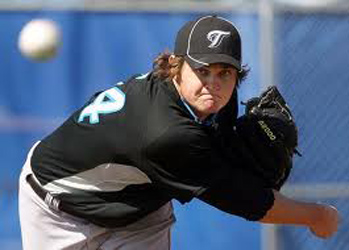
14. Aaron Sanchez, RHP
Born July 1, 1992. Selected in the 1st round (supplemental) of the 2010 draft.
| Year | Age | Level | G | GS | IP | H/9 | HR/9 | BB/9 | K/9 | ERA |
| 2010 |
18 |
Rk |
8 |
8 |
19.0 |
9.00 |
0.47 |
5.68 |
13.26 |
1.42 |
| 2010 |
18 |
A- |
2 |
2 |
6.0 |
6.00 |
0.00 |
7.50 |
13.50 |
4.50 |
Aaron Sanchez was selected thirty-fourth overall in this year's draft. He was born on Canada Day which pre-destined him to be selected by the Jays. Pre-draft Sanchez was listed at 6'3" and 175 lbs, although the Jays have him listed at 6'4" and 190 lbs. His meal ticket is a mid-90's fastball which he complements with a curveball and a Jays-issue change-up. In their pre-draft write-up Baseball America thought Sanchez's fastball was too straight and his mechanics needed to be cleaned up.
After signing Sanchez was assigned by the Jays to the GCL where he started eight games. He punched out 28 hitters in 19 innings but also walked twelve while giving up nineteen hits in those nineteen innings. Late in the season Sanchez was promoted to Auburn where he made two starts with similar results, more K's than IP, too many walks and just a few hits. These numbers show that improving his command is the top task for Sanchez in 2011, when he will most likely stay in Florida for extended spring training and then be assigned to one of the short-season teams. If he does improve that command he could get a shot to pitch in Lansing.
Sanchez is from Barstow, California, midway between LA and Las Vegas, so if he does eventually get to pitch for Las Vegas it will be like a homecoming for him.
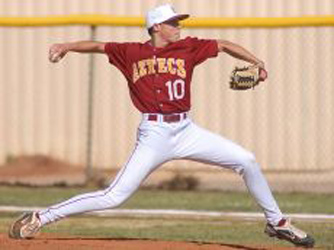
13. Asher Wojciechowski, RHP
Born December 21, 1988. Selected in the 1st round (supplemental) of the 2010 draft.
| Year | Age | Level | G | GS | IP | H/9 | HR/9 | BB/9 | K/9 | ERA |
| 2010 |
21 |
A- |
3 |
3 |
12.0 |
4.50 |
0.00 |
3.00 |
8.25 |
0.75 |
The general consensus amongst prospect gurus is that the Jays organization got a steal when it selected Wojciechowski with the 41st overall pick of the 2010 draft. The right-hander was selected out of the same college – The Citadel – as former Jays farmhand Chip Cannon. In his final college season, the junior posted a 3.64 FIP, a walk rate of 2.29 BB/9 and a strikeout rate of 11.10 K/9 in 125.2 innings. He throws from a three-quarter arm slot with some effort but he does a good job of using his legs (although it could be the cause of some of his command issues). A monster on the mound at 6’4’’ 230 lbs, Wojciechowski can dial his heater up to 95-96 mph and he possesses a plus slider. His changeup is a work in progress and he could end up at the back-end of the bullpen if it fails to develop. If he sticks in the starting rotation, though, he could develop into a No. 2 or 3 starter. Wojciechowski’s pro debut ended after just three starts; the club stated that it was simply to limit his innings, while other suggested he was suffering from an injury (although it was not considered serious). He could open 2011 in high-A Dunedin, possible along with the club’s first pick Deck McGuire.
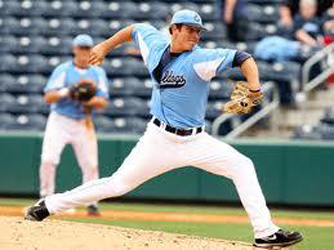
12. Anthony Gose, CF
Born August 10, 1990. Selected in the 2nd round of the 2008 draft.
| Year | Age | Level | AB | 2B | 3B | HR | BB | K | SB | CS | AVG | OBP | SLG |
| 2008 |
17 |
R |
39 |
2 |
1 |
0 |
1 |
12 |
3 |
1 |
.256 |
.293 |
.359 |
| 2009 |
18 |
A |
510 |
24 |
9 |
2 |
35 | 110 | 76 |
20 |
.259 |
.323 |
.353 |
| 2010 |
19 |
A+* |
512 |
20 |
13 |
7 |
45 | 132 | 45 |
32 |
.262 |
.328 |
.393 |
*Combined statistics between Clearwater and Dunedin.
The Blue Jays surprised everyone earlier this year when they traded Brett Wallace, widely seen as the first baseman of the future, to the Astros for the less well regarded Anthony Gose. Only 19, the Blue Jays assigned Gose to Dunedin, in the same Florida State League where he had previously been playing for the Clearwater Phillies. Gose hit .255/.360/.426 in 113 plate appearances for Dunedin with 3 doubles, 2 triples and 3 home runs, displaying more power and patience in the Jays organization than he had previously.
Gose has two tools that stand out to anyone watching him for the first time: his speed and his arm. In 2009, Gose led all of minor league baseball with 76 steals in 96 attempts, good for a solid 79.6% success rate. He took a step backwards this year though, managing only 45 stolen bases in 77 attempts, a 58.4% success rate. Gose attributes this dip to a loss of confidence after he was caught several times early in the year, getting bad jumps or running in bad counts. He has acknowledged that he needs to learn more as a base runner, though his 2009 manager, Dusty Wathan, believes Gose has good instincts, stating, “He’s not the fastest, but he’s the fastest around the bases.” Gose’s arm also stands out. He used to pitch in high school, reportedly reaching 95 mph, and he notched 13 assists in 2009 and 16 in 2010. His combination of speed and arm strength should make him an outstanding defensive outfielder.
It is easy to see why Gose, named the South Atlantic League's most exciting prospect in 2009, appealed to the Jays. The team does not have many speedy athletic outfielders in the system, especially not with some of the power power potential Gose has flashed. Wathan has said he has “plus-power” and speculated he could hit 20 homers a year in the majors if he continues to develop. A left-handed batter, Gose has a line-drive swing and uses his speed to take an extra base on hits into the outfield gaps. He’ll probably return to Dunedin to begin the 2011 season and continue to develop his approach at the plate, contact abilities and batting eye. If he can bump up his average, cut down on his strikeouts and rebound from a disappointing 2010 on the bases, there is a good chance Gose could become a consistent top of the order threat the Jays have often been lacking.
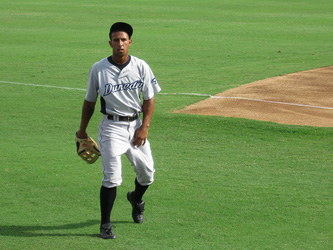
11. Jake Marisnick, OF
Born March 30, 1991. Selected in the 3rd round of the 2009 draft.
| Year | Age | Level | AB | 2B | 3B | HR | BB | K | SB | CS | AVG | OBP | SLG |
| 2010 |
19 |
R |
122 |
12 |
0 |
3 |
13 |
18 |
14 |
1 |
.287 |
.373 |
.459 |
| 2010 |
19 |
A |
127 |
8 |
2 |
1 |
9 |
37 |
9 |
2 |
.220 |
.298 |
.339 |
The Jays’ 2009 draft was a mess as the club failed to come to terms with three of its top four picks. The organization took that money that it failed to hand out and gave it to over-draft picks like Drew Hutchison and Marisnick, who secured a deal for $1 million as a third-round pick. The California prep outfielder did not play in ’09 due to his late agreement but he showed little rust in 2010 when he began his season in the Gulf Coast League this past June. Marisnick, 19, posted a .411 wOBA in 35 games, as well as a triple-slash line of .287/.373/.459. He showed a nice combination of power (.172 ISO) and speed (14 steals in 15 attempts). Moved up to low-A Lansing, Marisnick struggled against the more-advanced pitchers and hit just .220/.298/.339 in 34 games. His ISO rate dropped down to .118 but he nabbed another nine bases in 11 tries. Marisnick’s plate rates fluctuated with the promotion and his walk rate went from 9.2 to 6.3 BB% and his strikeout rate increased from 14.8 to 29.1 K%. Defensively, he plays a good center field but could move to right field as he fills out. He’ll work on making more consistent contact when he returns to Lansing in 2011.
